TRANSPORTATION
Click to see airport, lodging, maps, and general visitor information.
Parking
(Parking is limited and very expensive on the Stanford Campus. Use of Uber, Lyft or public transportation is highly encouraged.)
The closest parking structure to Paul Brest Hall and the CERAS building is ‘Parking Structure 6’, an underground parking garage located under Wilbur Field. To navigate to the garage entrance use address 560 Wilbur Way Stanford, CA 94305 on google maps. Visitor pay spots are located on the first level.
After exiting the garage, walk along Bowdin Lane. To reach the CERAS building, turn slightly right onto Galvez Street. CERAS will be on your left. CERAS is located at 520 Galvez Street.
To instead reach Paul Brest Hall, at the end of Bowdin Lane, turn slightly left and continue on Nathan Abbott Way. Paul Brest Hall will be on the left. Paul Brest Hall is located at 555 Salvatierra Walk.
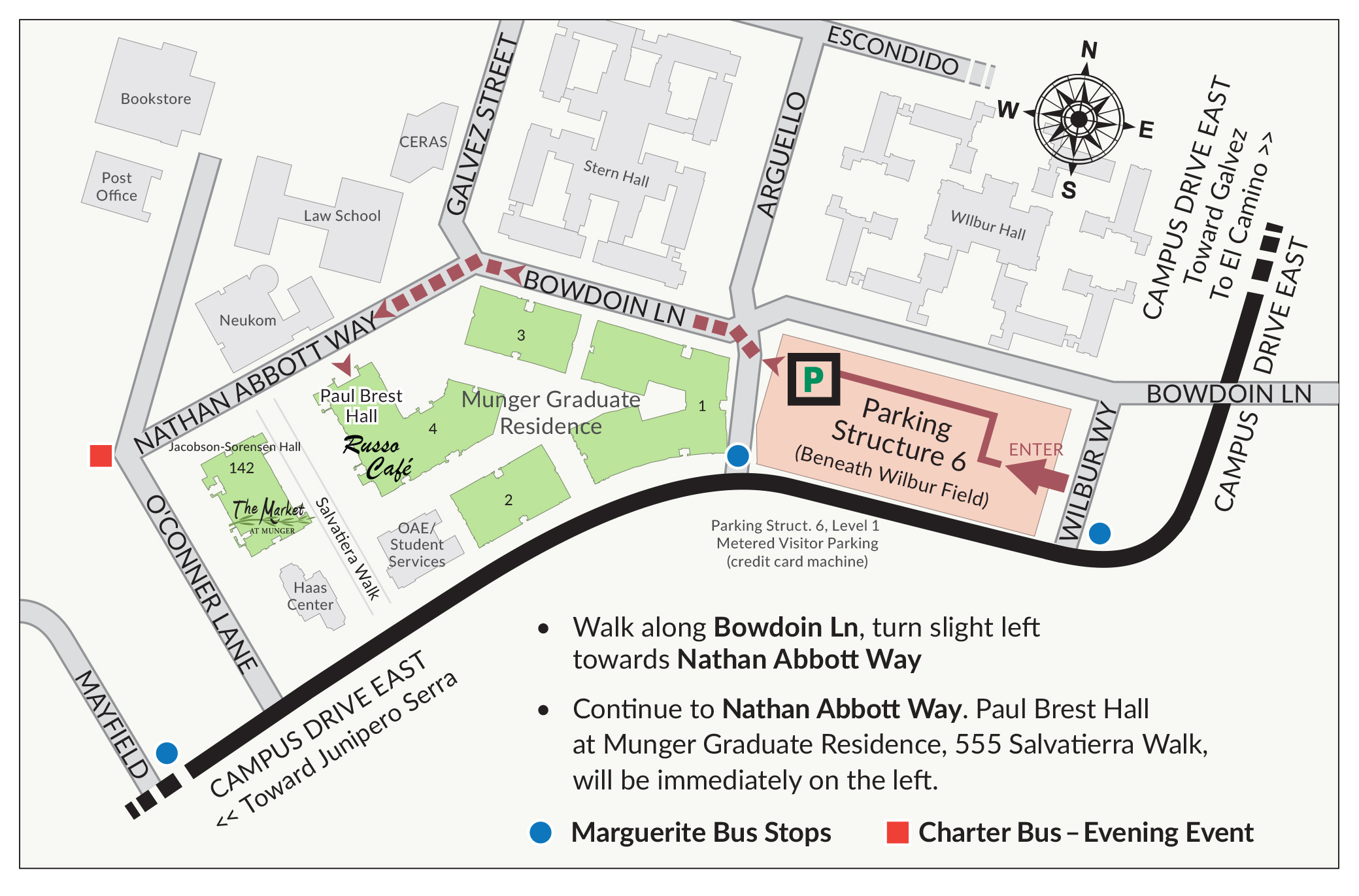
If there are no free visitor parking spots in Parking Structure 6, you can go to the Tressider Parking Lot located at 436 Mayfield Ave, Stanford, CA 94305.
Uber and Lyft
These are both good options for getting on and off campus, but you need to make sure you give the driver the address “520 Galvez Street, Stanford CA, 94305” for the CERAS building. – otherwise their GPS systems get lost on on-campus streets. Paul Brest Hall is located at 555 Salvatierra Walk, Stanford, CA 94305.
Caltrain
Caltrain is the commuter rail line that runs on the San Francisco Peninsula. To reach Stanford get off at Palo Alto Station.
You can find the Caltrain weekday schedule here.
Stanford Marguerite Shuttle
The Marguerite Shuttle is Stanford’s free campus bus system. It can be used to travel from the Palo Alto Caltrain Station to CERAS.
(Note: The X and Y have the same route, but go in opposite directions, so it’s faster to take the Y line to reach CERAS, and the X to leave it. The N and O are night versions of the X and Y.)
To reach CERAS or Paul Brest Hall, take the P or Y lines from Palo Alto Caltrain Station:
- The Y will take you very close to CERAS and Paul Brest Hall (you want to get off at the Munger complex)
- The P will take you to the Campus Oval: CERAS and Paul Brest Hall are a 10-minute walk from there.
To leave CERAS or Paul Brest Hall and get to Palo Alto Caltrain Station, take the SE, X, N, or P lines:
- You can catch the SE near Munger.
- The SE heading for the “Stanford Shopping Center” will take you to Palo Alto Caltrain Station (good if you’re staying at the Cardinal, Sheraton or in downtown Palo Alto).
- Take the N or X near Hoover Tower or Munger.
- For the P line, you’ll need to walk to the Campus Oval (10 minutes away).
General
CERAS building maps and directions.
Paul Brest Hall maps and directions.
*************************************************************************
ARCHIVED SUBMISSION INFORMATION
*************************************************************************
STUDENT VOLUNTEER APPLICATIONS
Submission deadline: Submission window closed.
Registration is free for all accepted student volunteers. To apply, please fill out this form: https://goo.gl/forms/
RESEARCH AND DESIGN COMPETITION
Submission deadline: Submission window closed.
IDC Design Challenge 2017
Designing for Rural Learners
In the spirit of IDC’s long history of co-design with youth, we invited students from two schools to propose design challenges for the researchers of IDC. Guided by their teachers, the students suggested, agreed on, and explained the problems and challenges that they would like the IDC community to help with. These same students will serve as judges for the competition: they will write feedback to all submissions, select finalists, and vote on the final winners.
Where These Challenges Came From
Ban Samkha and Nederland are a world apart, but share much in common. Ban Samkha is a rural village in the mountains of northern Thailand. Nederland is a rural mountain town in Colorado. When we asked students in both schools about the needs that they wish technology designers could help with, we found that there was considerable overlap. Two of those needs are represented by the challenges below.

Students at Ban Samkha Primary School in rural mountain northern Thailand.
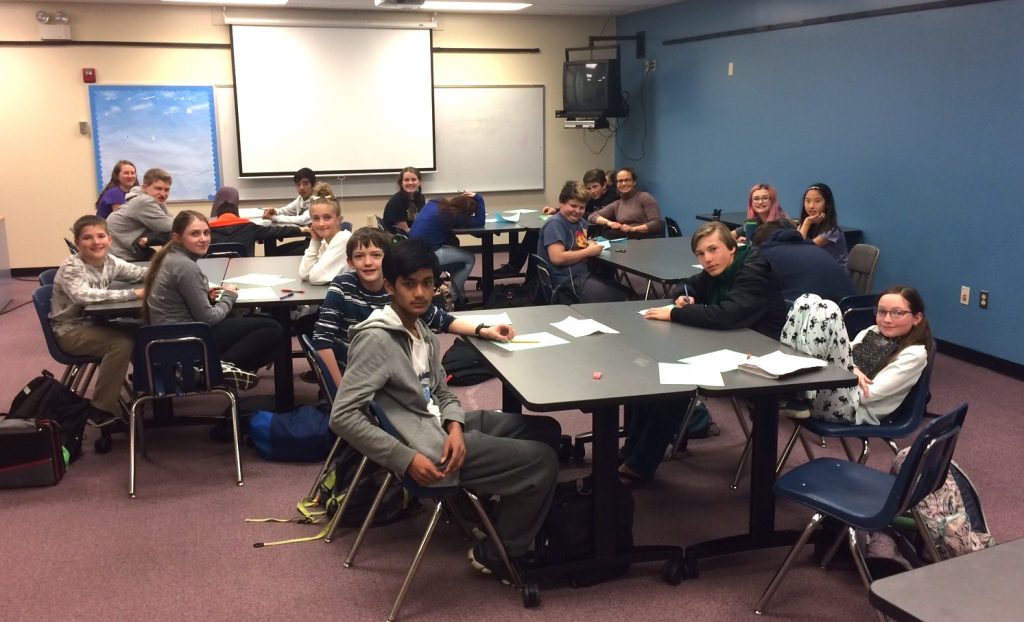
Students at Nederland Middle-Senior High school in rural mountain Colorado.
Important Dates
- Apr 30: Deadline for the initial submission
- May 5: Gather feedback from kids (internal)
- May 10-20: Announce results and feedback for revision
- May 31: Deadline for the final submission.
- June 27-30: Presentation at the conference
Presentation & Prize
Finalists will share their design concepts in poster presentations at the conference, as well as each have two minutes in front of the conference to share their visions. We will announce the winners at the close of the conference.
There will be one winner for each challenge which will be highlighted on the IDC website. A certificate of recognition will be presented during the conference.
Challenge 1
Design tools for young people to prevent, detect, and warn people about catastrophic natural disasters. Examples: forest fires, floods, and deforestation.
Context: Situation in Ban Samkha
Deforestation is a serious issue. Located at the foot of a mountain range, the village’s water source is a nearby reservoir that collects water from the forest above. Human caused forest fire in the dry season has been a chronic problem for decades.
“The topic is extremely relevant to our life. In the back of the school, there is 1,000 acreage of forest. The forest has valuable wild products such as local vegetable and ant’s egg. So, forest fires affect our parent’s income and also effect to us too. We find fruit to eat in the forest. It’s our free time activity. I will be sad if forest fires destroy parts of the forest and I will be very sad if the fire is caused by people.
Some of the villagers here believe that burning the forest will give them more products to collect emerging from the ashes, which is not true. In the village, we have campaigns to tell people the right information about vegetable growth. Changing people’s believe is so hard. We need to continue to communicate with them for a while.”
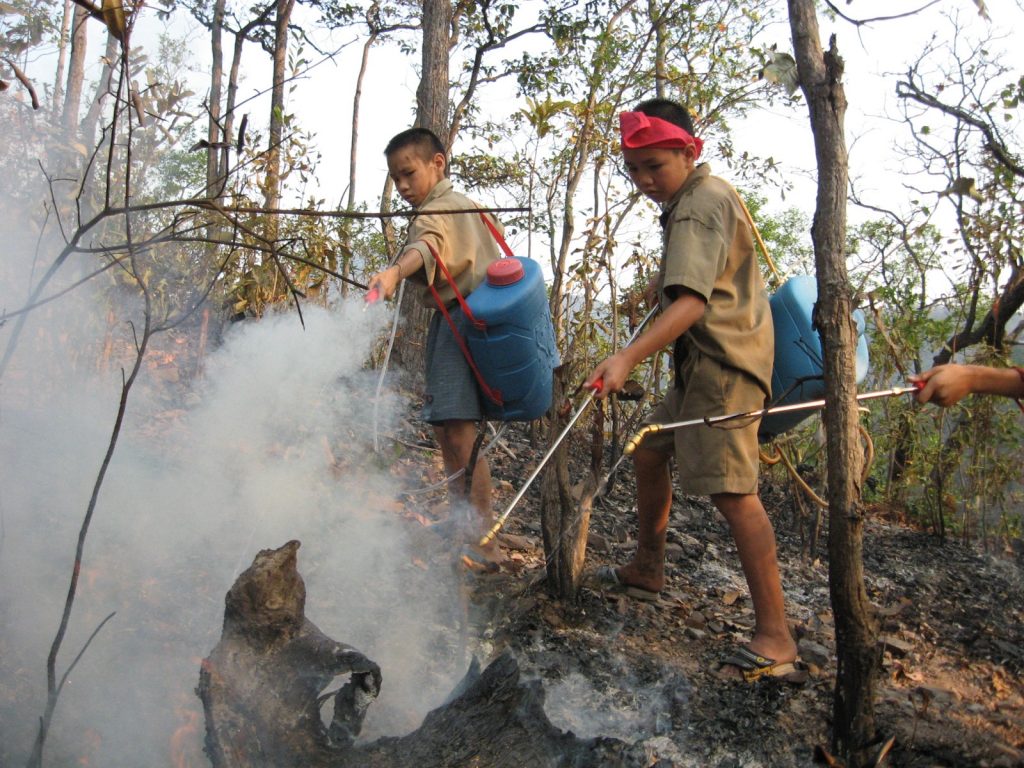
Photo of Ban Samkha students putting out a nearby forest fire as part of their community’s save-the-forest effort.
Context: Fire in Nederland
“Design challenge #1 is very important not only to my community, but humanity as a whole. The natural disasters that plague our planet are a problem we all have to become aware of, no matter what our financial status, political stance, or personal beliefs we all need to agree that saving lives is the most important goal we can focus on today. By designing an early warning system, we can preserve sacred places, save lives, and improve our planet over all. This challenge is the most important thing we can focus on. Not only for us, but for our future as well.
I know this is important because a few of my friends last year were evacuated, and a friend’s neighbor’s house was burned to the ground because of that fire. My family and I were on pre-evacuation. They had several horses, a donkey, and two dogs. One of the dogs was saved but the other died and its body wasn’t found. The donkey died. This is how the fire affected my community and friends.”
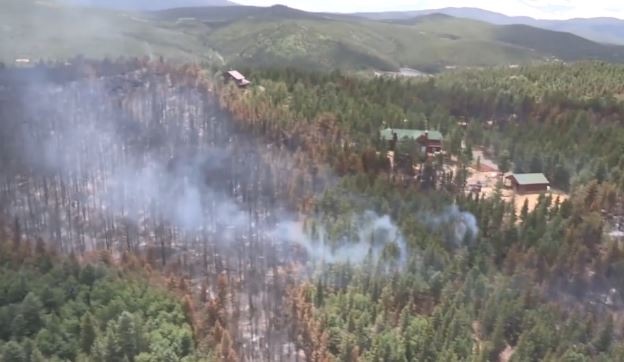
Photo of 2016 Cold Springs Fire from The Daily Camera
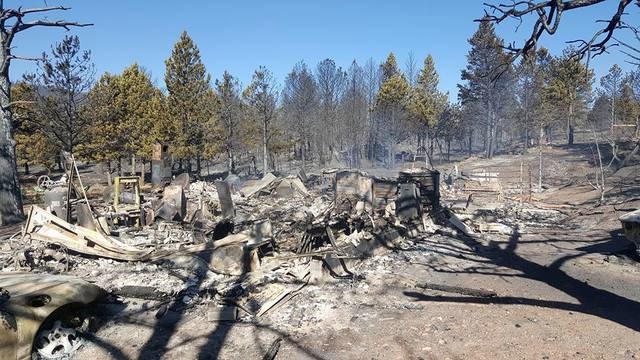
Photo of Cold Springs Fire Aftermath from thedenverchannel.com

Redacted flyer for a firefighter’s missing dog Geno after the Cold Springs Fire. The firefighters lost their home while protecting their neighbors, and Geno was never found.
Challenge 2
Create mindful & kindful social support tools: tools to help young people be considerate of their own and others’ feelings (in person or online).
Stories from Ban Samkha
“My friends say bad words to me sometimes and I don’t like it. One time I told my friend that he was speaking with a bad habit. He said to me that he does not think it is bad because everybody at his home is talking this way. So I told the teacher about his bad word. The teacher then called both of us and talked about how good conversation should be. I am bored because I know it already. Why do I need to listen to this just because my friend doesn’t know it. My teacher said I can make a better friend by sacrificing my time to listen with my friend.”
“I play on my parent’s mobile phone in the evening with my own login. I got a bad sentence from my friend in my inbox. I replied to them with a bad sentence too. My parents saw the conversation and brought mobile phone to the teacher. Teacher told us that many bad things can happen from bad conversations. We didn’t know about this before neither did our parents.”
Stories from Nederland
“The Design Challenge I choose was Challenge 2, which is about the mindful and supportive tools to help younger people talk online and in life. Sometimes people say things they don’t mean that end up leading into a larger argument, or they get worked up over nothing and ignore each other. One time I was getting extremely worked up about something so little, that I hurt my best friend. I wish that I could take back everything I said over a text message. Another reason could be that some kids are antisocial, or they maybe scared to talk to other people. It would help them know what to say and what not to say to make friends, and relationships. Even though some people would not use this design, it would still help the people that want to learn how to speak to people.”
“This challenge is important to not only my community but many others. There have been countless times that I have gotten worked up and said something I shouldn’t have, or didn’t mean. I really wish there was a way to control what comes out my mouth or what I push sent on. When I get upset or emotional my rational part of my brain shuts down so I need a way to continue filtering. I have gotten in so much trouble with my big mouth and my brain turning off, if I had a way to control that then life for me and everyone else would be much better and happier.”
More stories from the Nederland and Ban Samkha children are available here.
How to Submit
Please upload your Research and Design Competition submissions here.
Contact Us
Send e-mail to arnans@eng.cmu.ac.th or ben.shapiro@colorado.edu
IDC 2017 welcomes submissions in the form of full papers, short papers (notes), demonstrations, workshops, courses, work in progress / late breaking and interactive child experiences. There is also a call for participants to submit to the doctoral consortium and for later submission to our Research and Design Competition. Submissions to all tracks (except the research and design competition for which a separate call will be announced) are invited on the following topics:
- Innovative interactive technologies for children
- Theoretically motivated arguments regarding interaction design and children
- Empirical studies concerned with the interaction of children and technology
- Methods and techniques supporting interaction design and children
- Studies of the effects of technology on children’s lives and development
- Reflective analyses on the field of child computer interaction and interaction design
- Constructive design research for and with children
- Studies discussing the involvement of children in the design process
- Future vision articles, discussing trends and directions for the field
All submissions must be anonymized for blind review.
Full Papers and Short Papers (Notes)
Submission deadline: submission window closed.
Full Papers and Short Papers (Notes) acceptances announced: 24 March 2017.
Intended to report original work not previously published elsewhere, Full Papers and Short Papers (Notes) may address any of the areas listed in the conference topics. Full Papers and Short Papers (Notes) should clearly state the contribution(s) in the paper and the abstract. Contributions making one clear, significant contribution are more likely to be accepted than those making several lesser contributions. Submissions to these categories must identify and cite relevant published work and explain how the paper furthers state of the art within Interaction Design and Children. Full Papers will be expected to be between 8 and 10 pages long – including references, Short Papers (Notes) will be expected to be between 4 and 6 pages – including references. We will use the ACM SIGCHI Paper Format, 2016 version. We encourage authors to select the venue based on the way their work writes up – rather than see Short Papers (Notes) as as inferior to Full Papers.
OPTIONAL supporting files, such as videos or source code, may be included. You may submit a link to a video hosted on a service like Vimeo or YouTube. This video must be anonymous and no longer than 5 minutes in length. Please also note that your paper must be a complete, stand-alone submission that makes sense without the video.
All accepted Full Papers and Short Papers (Notes) will be included in the conference proceedings published in the ACM Digital Library. Submissions for review should be anonymized and should adhere to the format provided in the template. Once accepted for publication, submissions will go through a light second review process. Publication of the paper is dependent on there being at least one author of the paper registered for the conference.
Workshops and Courses
Submission deadline:submission window closed.
Workshops provide a forum for in-depth discussions, resource exchange, and networking related to specific topics within IDC. A workshop may be half-day or full day in length, and typically have 15 to 20 participants. People interested in participating in a workshop can submit a position paper to the organizers of that workshop.
IDC2017 aims to also include two or three ninety-minute Courses for participants. Courses are different from workshops in which they are shorter and are intended to be more focused on one topic, with less time for discussion.
Please note that attendants must register for both the workshop/course and the IDC conference itself.
Potential organizers are invited to submit a workshop/course proposal consisting of the following components:
- A proposal in PDF format (no template necessary), describing (a) the scope of the workshop or course, (b) schedule, (c) organisers (with short bios, and previous experience teaching this or similar workshops), (d) target audience, (e) main topics covered, and (f) expected outcomes. The schedule should describe each activity/task that will take place during the workshop or course. The proposal should not to exceed 3000 words (no template necessary,) excluding the abstract and the call for participation (see items 3 and 4 below.)
- Type of submission: half-day workshop, full-day workshop, or 90-min course.
- Brief abstract to appear in the program
- 300-word call for participation that will be used to publicize your workshop or course.
Proposals will not undergo a full peer review, however an expert jury will consider each submission based on the workshop topic’s potential for generating community interest. Workshops and courses aligned to the conference themes will be especially welcomed. The conference organisers reserve the right to ask workshops and courses that are very similar to consider merging as a condition of acceptance.
Demos
Submission deadline:submission window closed.
Demos are interactive expositions of technologies and technology solutions. Demos should not been previously published or shown at previous editions of IDC. Authors are encouraged to demonstrate work in progress and late-breaking research results that show the latest innovative ideas.
Demos should be described in no more than 4 pages using the CHI Extended abstracts format. The explanation of the demo should include a section marked ‘Practical considerations’ where the authors will explain what might be needed to ensure the demo is well prepared.
Late Breaking / Work in Progress
Submission deadline:submission window closed.
Late breaking / Work in progress papers will be presented at the conference in a poster session. Papers in this category should be written up using the CHI Extended abstract format.
Late Breaking / Work in Progress papers should not exceed 6 pages in length including references. These papers will be peer reviewed and will be published in the ACM Digital library. This track is suited to late breaking work and work in progress. For this reason, papers that do not fit these categories will be less likely to be accepted for publication than those that do. We define “late breaking” work as current work that is very new, and we define “work in progress” work as early results in new studies.
Doctoral Consortium
Submission deadline:submission window closed.
The IDC2017 Doctoral Consortium is a forum for PhD students to present their work to a critical panel to receive feedback and guidance to help timely and successful completion of PhD research. It is a closed event in which only PhD students participate. Interested students should submit an extended research abstract (SIGCHI Extended Abstract template, up to 4 pages) describing: the research topic, the work done to date, the plan for the next stages of the work and the methods used / proposed to be used. Each submission must be accompanied by a letter from the candidate’s supervisory team/person confirming his / her eligibility for this venue.
Templates:
- Template for submission for Full Papers and Short Papers (Notes): SIGCHI Paper Format, 2016 version, http://www.sigchi.org/publications/chipubform/sigchi-paper-format-2016/view
- Template for submission for Doctoral Consortium, Demos, Late Breaking / Work in Progress: SIGCHI Extended Abstracts Format 2016, http://www.sigchi.org/publications/chipubform/sigchi-extended-abstracts-format-2016/view
- LaTeX templates available here: https://github.com/sigchi
